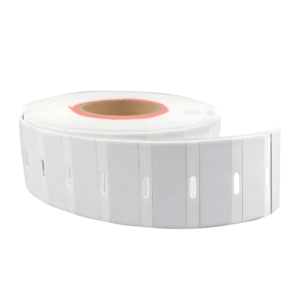
How to implement RFID technology in your cases
Radio Frequency Identification (RFID) refers to a wireless system comprised of two components: tags and readers. The reader is a device that has one or more antennas that emit radio waves and receive signals back from the RFID tag. Tags, which use radio waves to communicate their identity and other information to nearby readers, can be passive or active. Passive RFID tags are powered by the reader and do not have a battery. Active RFID tags are powered by batteries.
The tags contain electronically stored information and are identifiable within a few meters. Unlike barcodes, RFID tags do not need to be within the line of sight of the identifier and can also be embedded within the object being tracked.
RFID tags can store a range of information from one serial number to several pages of data. Readers can be mobile so that they can be carried by hand, or they can be mounted on a post or overhead. Reader systems can also be built into the architecture of a cabinet, room, or building.
Tag: composed of coupling elements and chips, each tag has a unique electronic code, which is attached to the object to identify the target object;
Reader: a device that reads (sometimes can also write) tag information, which can be designed as handheld or fixed;
Antenna: transmits radio frequency signals between the tag and the reader.
RFID tags are physical carriers of Electronic Product Codes (EPCs) that are attached to trackable items and can be circulated around the world to identify and read and write them. At present, the common coding systems for electronic products are mainly EPC codes supported by Europe and the United States and UID codes supported by Japan.
Tag memory is divided into Reserved (reserved), EPC (electronic product code), TID (tag identification number) and User (user) four independent Bank (storage block).
Reserved: Store Kill Password (deactivation password) and Access Password (access password).
EPC: Stores EPC numbers, etc.
TID: Store the tag identification number, each TID number should be unique.
User: Stores user-defined data.
EPC coding builds a system that lets ‘every commodity speak’ in the world
In 1999, a genius professor from the Massachusetts Institute of Technology put forward the idea of EPC open network, which has been widely used in International Barcode Organization (EAN.UCC), Procter & Gamble (P&G), Coke, Wal-Mart, FedEx, Nestle, British Telecom SUN, PHILIPS, With the support of 83 multinational companies around the world, including IBM, this development plan began.
In October 2003, the EPC GLOBLE global organization was established internationally to promote the application of EPC and the Internet of Things. At that time, developed countries such as Europe, the United States, and Japan made every effort to promote the application of electronic labels that conform to EPC technology. The US Department of Defense, the United States, Europe, Japan’s production enterprises and retail enterprises have developed a plan to implement electronic tags in 2004-2005.
The EPC code is a new generation of product coding system launched by the International Barcode Organization. The original product barcode is only a code for product classification. EPC is to assign a global unique code to each single product. The EPC code adopts a 96-bit (binary) method. coding system. The 96-bit EPC code can assign codes to 268 million companies, each company can have 16 million product categories, and each product category has 68 billion independent product codes.
The RFID radio frequency identification system includes EPC electronic tags and RFID readers. The EPC electronic tags are number carriers. Through the RFID readers, the information of the EPC electronic tags can be read, and the information is transmitted to the Internet of Things middleware through the RFID readers. After processing, it is stored in a distributed database.
The RFID radio frequency identification system includes EPC electronic tags and RFID readers. ” title_text=”The RFID radio frequency identification system includes EPC electronic tags and RFID readers.
RFID systems use radio waves at several different frequencies to transfer data.” title_text=”RFID systems use radio waves at several different frequencies to transfer data.”
The EPC information network system is mainly composed of three parts: EPC information service, EPC middleware and discovery service:
- EPC information service (software support system of EPC system), which is used to realize the interaction of EPC information by end users in the Internet of Things environment.
- EPC middleware is the link between the RFID reader and the information system. It is used to realize the standardization of each small application environment or system and the communication between them, and set up a common platform and interface between the background application software and the RFID reader, which is usually called middleware. The EPC middleware realizes the information interaction between the RFID reader and the back-end application system, captures real-time information and events, or upstream to the back-end application database system and ERP system, or downstream to the RFID reader.
- The discovery service obtains EPC data access channel information based on the electronic product code. EPC information discovery service mainly includes Object Name Resolution Service (ONS) and supporting services.
An EPC Internet of Things architecture should be mainly composed of EPC codes, EPC tags and RFID readers, middleware systems, Object Name Resolution (ONS) servers and EPC information services to realize the global Internet of Things.
The EPC code has enough coding capacity, from the total population of the world (more than 6 billion) to the total number of grains of rice in the world (roughly estimated at 100 million), and the EPC code has enough space to identify all these objects. In order to ensure the uniqueness of the EPC code, EPC Global allocates its own EPC code through the global coding organizations, and establishes a corresponding management system
EPC code consists of version number, product domain name management, product classification part and serial number. EPC coding structure standards include: EPC-64, EPC-96, EPC-256.
For example, the wine EPC(Select EPC-64 for EPC ID encoding) label data information is designed as APC+PTC+ATC+UID, and each block is allocated 16b data, which can also be allocated as needed. Among them, APC is the manufacturer code, PTC is the product type code, ATC is the origin and production date, and UID is the unique serial identification code of a single product.
EPC encoding has the following characteristics:
- Comprehensiveness
EPC codes can be used in comprehensive applications in supply chain links such as production, circulation, storage, settlement, tracking and recall.
- Scientific
Well-structured, easy to use and maintain.
- Compatibility
The EPC coding standard is compatible with the currently widely used EAN.UCC coding standard. GTIN is an important part of the EPC coding structure. Currently widely used GTIN, SSCC, GLN, etc. can be smoothly converted to EPC.
RFID systems use radio waves at several different frequencies to transfer data. In health care and hospital settings, RFID technologies include the following applications:
- Inventory control
- Equipment tracking
- Out-of-bed detection and fall detection
- Personnel tracking
- Ensuring that patients receive the correct medications and medical devices
- Preventing the distribution of counterfeit drugs and medical devices
- Monitoring patients
- Providing data for electronic medical records systems





